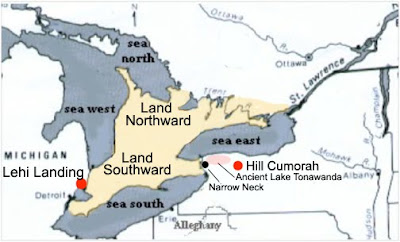“Once again, taking the scriptures at face value, as we all should, we would have to assume a north and south sea are pertinent to the geographical location of the Book of Mormon lands. In the New York setting the four seas described are clearly defined. While the seas which bordered the land southward were referred to as the west sea (Lake Erie) and the east sea (A Genesee Lake), both proper names, the seas mentioned in relation to the those in the land northward were referred to in relation to their placement in the land. It seems that as more and more Nephites began moving northward, they ultimately spread, insomuch that they filled every river valley in southern Ontario, from Georgian Bay on the north (sea north) to Lake Erie on the south (sea south), and from Lake Huron on the west (sea west) to Lake Ontario on the east (sea east)—the lakes referred to by their positions in the land, not by name, for the east sea proper was further south.”
She also includes a map showing the four seas mentioned (I have taken the liberty of inserting the Land Northward, Land Southward, Hill Cumorah, and Lehi’s Landing Site, based on Mormon’s numerous references, within her location of the four seas, and also placed her own locations for the Ancient Lake Tonawanda, and her Narrow Neck of Land):
 As one can easily see, there are certain inconsistencies between this map, or location of the four seas, by Olive, and the geographical description by Mormon:
As one can easily see, there are certain inconsistencies between this map, or location of the four seas, by Olive, and the geographical description by Mormon:
1. The Land Northward and the Land Southward, by definition, must be located within the four seas which bordered the entire Land of Promise (so by naming these current lakes, she limits the location of the actual Land of Promise as Mormon describes it)
2. This area of the Land of Promise is extremely limited in size, is basically wider (east to west) than it is long (north to south), though this does not match the scriptural references.
3. The Land of First Inheritance was located on the west sea south (which would put it around the present day city of Detroit on her map); however, there was no way to get a ship into this area from any direction, requiring a very, very long walk--many hundreds of miles--from the nearest penetration of a deep sea sailing ship “driven forth before the wind.”
4. The Hill Cumorah in upper New York State is not even located within the Land of Promise area as Mormon described it, but lies outside and beyond the East Sea.
5. The Sea North is really the smallest of the four seas shown, yet Ripliancum is described as “to exceed all” and is obviously far smaller than her West Sea.
6. The Narrow Neck of Land does not qualify regarding her placement of the Sea East and the Sea South which would cause the Land Southward to be placed to the south of the Sea East and east and south of the Sea South—neither of which description matches anything Mormon described.
7. Her use of the ancient Lake Tonawanda, just south of Lake Ontario, is claimed to be her sea that divides the land—but there is no land that is divided by the parameters of that ancient lake bed according to geological descriptions. As shown in a previous post, the ancient Tonawanda Lake was not a solid mass of water, but broken up by islands and land masses (one should study the geological record to see how Lake Erie, the Niagara River and the entire Niagara Escarpment was affected at this time, which would have severely changed the appearance of this area as we now know it and Olive has used to be the same as in ancient times with Tonawanda in existence).
In addition, Olive claims: “The sea that divides the land is one of the most important landmarks in all of Book of Mormon territory and is key to the overall understanding of the geographical layout of the Book of Mormon. It defines the lands northward and southward and lays just to the north of Bountiful.”
However, there is no way this sea is anywhere near as important as the Narrow Neck of Land, which is described in several places in the scriptural record as the feature that kept the Land Northward in possession of the Nephites. In addition, the Sea that Divides the Land is mentioned only once—only once!—and not even by Mormon, but by Ether and only in connection with a city that was built by the Jaredites in the Land of Desolation—a city, by the way, that is not found today in any state of ruin in the area. It is inconceivable to determine "the sea that divides the land" is the most crucial point and "is key to the overall understanding of the geographical layout of the Book of Mormon" since the only thing we know is that it, or a part of it, was near the narrow neck of land. There is, as has been written here many times, a far more understandable explanation of Mormon's statement.
As to the most important feature of the Land of Promise, Mormon makes it very clear that the entire Land Southward, specifically outlining the Land of Nephi and the Land of Zarahemla, were completely surrounded by water except for this narrow neck of land.
Obviously, the Great Lake Theorists, no matter which one is studied, have failed to show a consistency in matching the scriptural record. Beginning with the location of the Hill Cumorah, each has tried to place the geographical descritions of Mormon’s writings into this area—and all have failed.




No comments:
Post a Comment